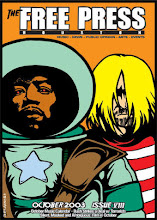Taxi to the Dark Side

Alex Gibney opened his previous film, Enron: The Smartest Guys in the Room with a glossy recreation of a suicide in a nice car. In Taxi to the Dark Side Gibney concludes the film with a high tone sequence that shows the buildings of power in Washington D.C. cruising past in the background with a prominent taxi sign on top of a cab dominating the foreground. Gibney uses his imagery with style and he backs up his sleek look with facts and figures that reveal a morass of corruption.
Taxi to the Dark Side takes an unblinking look at torture and its use in the current conflict in Iraq, Afghanistan and Guantanamo Bay. The film is bracketed with the story of one innocent Afghan who was mistaken for a Taliban rouge, imprisoned at Bagram Air Base and within five days was dead in his cell. The meat of the film takes a macro view of torture and how it’s applied throughout the entire war. Irony of ironies, the individual, a cab driver named Dilawar, was turned in by Afghan rebels who were themselves shelling the U.S. military and then capturing everyday Afghan guys and turning them over to the Army. This is a story where the good guys are the ones that pay with their lives.
You’ve seen the photos of Lindy England and the prisoners in the hallway but in this film you see the entire photograph before the media cropped it. Comprehensively the movie covers torture in the last half of the 20th century while leading up to the current situation at Abu Ghraib. Footage includes North Vietnamese film of U.S. Navy prisoner of war John McCain, lying prone, telling his interrogators he loves his wife. Another clip features Professor Alfred McCoy, author of A Question of Torture explaining the various techniques of the spy trade. Water boarding comes from medieval times where it was used because it was so horrific. Contemporary twists on torture have been developed by intelligence agencies that prefer psychological disorientation. The Nazis used mescaline on prisoners in the 30s but their victims opened up so willingly it was discouraged in favor of more brutal methods.
McCoy’s book can be found in its entirety on Google books (ah the internet) and fleshes out the historical uses of torture. Remember the French Fries versus Freedom Fries backlash at the start of the whole terrorist era? McCoy outlines how in the 1950s the French declared Algerian rebels outlaws and not combatants and thus bypassed all rules of the Geneva Convention in their war in Algeria.
At this year’s Oscars Gibney’s Taxi to the Dark Side won the award for best documentary. For Gibney it was win-win situation because he also executive produced No End in Sight, another docu from 07 that gave Taxi a run for the money in the well-researched information the major news orgs don’t cater to category. Gibney doesn’t have the clout of Michael Moore but he also doesn’t carry the baggage associated with Moore’s flamboyant demeanor. Visually Gibney leans close to the Errol Morris school of high contrast talking heads coupled with information overload. And that’s a good thing.









0 Comments:
Post a Comment
<< Home